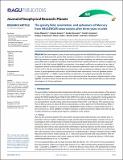The gravity field, orientation, and ephemeris of Mercury from MESSENGER observations after three years in orbit
Author(s)
Mazarico, Erwan Matias; Genova, Antonio; Goossens, Sander; Lemoine, Frank G.; Neumann, Gregory A.; Solomon, Sean C.; Zuber, Maria; Smith, David Edmund; ... Show more Show less
DownloadZuber_The gravity.pdf (3.773Mb)
PUBLISHER_CC
Publisher with Creative Commons License
Creative Commons Attribution
Terms of use
Metadata
Show full item recordAbstract
We have analyzed 3 years of radio tracking data from the MESSENGER spacecraft in orbit around Mercury and determined the gravity field, planetary orientation, and ephemeris of the innermost planet. With improvements in spatial coverage, force modeling, and data weighting, we refined an earlier global gravity field both in quality and resolution, and we present here a spherical harmonic solution to degree and order 50. In this field, termed HgM005, uncertainties in low-degree coefficients are reduced by an order of magnitude relative to earlier global fields, and we obtained a preliminary value of the tidal Love number k[subscript 2] of 0.451 ± 0.014. We also estimated Mercury's pole position, and we obtained an obliquity value of 2.06 ± 0.16 arcmin, in good agreement with analysis of Earth-based radar observations. From our updated rotation period (58.646146 ± 0.000011 days) and Mercury ephemeris, we verified experimentally the planet's 3:2 spin-orbit resonance to greater accuracy than previously possible. We present a detailed analysis of the HgM005 covariance matrix, and we describe some near-circular frozen orbits around Mercury that could be advantageous for future exploration.
Date issued
2014-12Department
Massachusetts Institute of Technology. Department of Earth, Atmospheric, and Planetary SciencesJournal
Journal of Geophysical Research: Planets
Publisher
American Geophysical Union (AGU)
Citation
Mazarico, Erwan, Antonio Genova, Sander Goossens, Frank G. Lemoine, Gregory A. Neumann, Maria T. Zuber, David E. Smith, and Sean C. Solomon. “The Gravity Field, Orientation, and Ephemeris of Mercury from MESSENGER Observations after Three Years in Orbit.” Journal of Geophysical Research: Planets 119, no. 12 (December 2014): 2417–2436.
Version: Final published version
ISSN
21699097
2169-9100